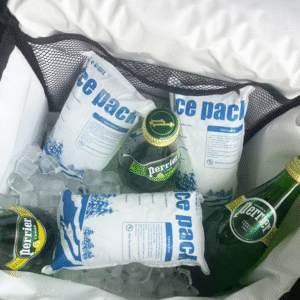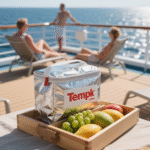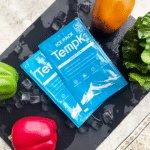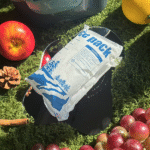FDA Approved Dry Ice Packs for Lunch Box: How to Keep Your Lunch Safe and Fresh
You care about the health of your family, and the simplest way to show it is by packing a safe and enjoyable lunch. FDA approved dry ice packs for lunch box use food safe materials to keep perishable foods cold, maintain flavour, and prevent harmful bacteria from growing. Al final de este artículo, you’ll know how to choose and use these packs correctly and stay ahead of evolving cold chain trends. You will also discover why the materials and handling instructions matter, which options suit different lifestyles, and how innovations like IoT enabled packaging are shaping the future.
Why FDA approval matters and what makes a dry ice pack safe for food: learn about the temperature “danger zone” and how approved plastics like HDPE and polypropylene protect your meals.
How to choose and use FDA approved dry ice packs for lunch boxes: step by step packing guidance, maintenance tips, and what to avoid according to the USDA and FSIS.
Comparisons between dry ice packs and traditional gel packs: understand which option suits your needs based on temperature requirements, facilidad de uso, and regulatory considerations.
Latest trends and innovations in cold chain packaging for 2025: see how reusable packaging, sensores inteligentes, and sustainability goals are reshaping the market.
Practical FAQs and real world scenarios: get answers to common questions about food safety, proper handling, and packing hacks.
Why Do You Need FDA Approved Dry Ice Packs for Your Lunch Box?
Understanding Food Safety and the Temperature Danger Zone
Bacteria multiply quickly between 40 °F and 140 °F, known as the temperature danger zone. According to the Food Safety and Inspection Service (FSIS) and university extension programs, perishable foods should not remain in this range for more than two hours (one hour if ambient temperature exceeds 90 °F). When you pack a lunch for work or school, you’re often away from a refrigerator for several hours. Without proper insulation and a cold source, sándwiches, ensaladas, productos lácteos, and meats can quickly become unsafe to eat. FDA approved dry ice packs for lunch box maintain the contents below 40 °F, keeping meals fresh and safe.
Why FDA Approval Matters
The United States Food and Drug Administration does not “approve” dry ice itself; en cambio, it regulates the materials used to contain or contact food. For a dry ice pack to be Aprobado por la FDA, its outer film, gel refrigerant, and adhesives must meet food contact standards (Title 21 CFR). The most common compliant materials are high density polyethylene (HDPE) y polypropylene (PÁGINAS). HDPE is recognized as food safe because it is durable, does not leach harmful chemicals, and resists mold and corrosion. Polypropylene is also considered one of the safest plastics; it is BPA free, has high heat tolerance, and is approved by the FDA and Environmental Protection Agency for food contact. Choosing an FDA approved dry ice pack ensures that no harmful substances migrate into your lunch.
How Cold Do FDA Approved Dry Ice Packs Keep Your Food?
Dry ice packs contain gel infused with dióxido de carbono sólido or specialized phase change materials that freeze at extremely low temperatures. Dry ice sublimates at –109.3 °F, providing far colder conditions than water based gel packs. This intense cold keeps foods frozen for extended periods and avoids the puddles of water that ordinary ice leaves behind. Sin embargo, direct contact between dry ice and food is unsafe because the intense cold can freeze and damage tissues; protective packaging or a spacer is always required.
Key Safety Guidelines for Using Dry Ice Packs
Always use an insulated lunch bag or box. FSIS notes that brown paper bags or thin plastic sacks cannot maintain safe temperatures; a soft sided insulated bag will better contain the cold.
Use at least two cold sources. To keep a lunch box cold, place one dry ice pack at the bottom of the bag and one on top of the food. Clemson University’s food safety extension states that two cold sources work together to maintain safe temperatures throughout the container. The USDA’s 2025 guidance recommends the same configuration.
Manipule el hielo seco con cuidado. Dry ice can cause frostbite or burns if touched directly. Wear insulated gloves or use tongs when handling it. Do not place dry ice in airtight containers; Mientras sublima, carbon dioxide gas builds pressure and may cause an explosion.
Vent the lunch box. Al usar hielo seco, ensure there is a vent or that the lid is not completely sealed. This allows carbon dioxide to escape, preventing dangerous pressure build up.
Dispose of dry ice safely. Unused dry ice should be placed in a well ventilated area and allowed to sublimate. Do not flush it or throw it in trash where it can harm waste handlers.
Real World Scenario: A Parent’s Lunch Box Challenge
Caso real: A working parent regularly packed a turkey sandwich, yogur, and fruit for her child’s school lunch during a California summer. Using two FDA approved dry ice packs – one below and one above the food – kept everything below 40 °F until lunchtime, according to a food thermometer. By following FSIS guidelines to pack perishable foods with an insulated lunch bag and two cold sources, she reduced the risk of foodborne illness and her child enjoyed a fresh, safe meal every day.
Which Materials Make Dry Ice Packs Food Safe?
The Role of High Density Polyethylene (HDPE)
HDPE is a durable, recyclable plastic widely used in milk jugs and food containers. Research and regulatory agencies recognize virgin HDPE as food safe. It resists chemicals, does not corrode, and has a smooth surface that prevents bacterial growth. FDA approved dry ice packs often use a multi layer film with an HDPE exterior to protect the gel. Some packs also incorporate recycled HDPE; when used for food contact, recycled HDPE must undergo stringent FDA review to ensure it does not contain contaminants.
Why Polypropylene (PÁGINAS) Is Considered Safe
Polipropileno (recycling code 5) is another popular material for dry ice pack exteriors. Health experts consider it among the safest plastics because it contains no bisphenol A (BPA), has a high melting point (arriba 320 °F), and remains chemically inert with most foods. Many yogurt and butter containers use polypropylene, which underscores its safety for food contact. When choosing FDA approved dry ice packs for your lunch box, look for packaging that lists PP or HDPE; avoid packs made of unknown plastics.
Food Grade Gel Refrigerants
The cooling core of a dry ice pack is typically a phase change gel. For FDA approval, this gel must use food grade ingredients that are non toxic and safe if leakage occurs. Some manufacturers incorporate polyacrylic salts, cellulose gums, o vegetable based gels. While the gel is not intended for consumption, using food grade ingredients ensures that accidental contact does not contaminate lunch. Avoid packs containing unknown chemicals or fragrances; reputable brands provide safety data sheets and compliance certifications.
Mesa 1. Food Safe Materials in Dry Ice Packs
| Material | FDA approval status | Key properties | Lo que significa para ti |
| High density polyethylene (HDPE) | Recognized as food safe; FDA approves virgin HDPE for direct food contact | Durable, chemical resistant, smooth surface | Keeps packs intact and prevents leaching into food |
| Polipropileno (PÁGINAS) | FDA approved and considered one of the safest plastics for food contact | BPA free, high heat tolerance, inert | Safe for daily use, resists deformation |
| Food grade gel | Must meet food contact standards under 21 CFR | Contains non toxic phase change materials | Maintains cold temperature; safe even if leakage occurs |
| Polyethylene terephthalate (MASCOTA) | Used in some pack exteriors; safe for short term food contact | Transparent, ligero | Helps you see the gel level; not ideal for high heat |
| Paperboard insulation | Often used as an outer sleeve | Biodegradable and renewable | Reduces condensation and improves handling comfort |
How to Choose and Use FDA Approved Dry Ice Packs for Lunch Boxes
Step by Step Packing Guide
Select the right lunch container. Opt for an insulated, soft sided lunch bag or rigid insulated lunch box. FSIS notes that brown paper bags do not maintain safe temperatures.
Choose the size and number of dry ice packs. Determine how much food you need to keep cold. For a standard lunch box, two small packs (aproximadamente 6 oz each) often suffice. The USDA recommends placing one pack below the food and another above to create a cold “sandwich”. For larger meals or longer commutes, consider larger packs or multiple pairs.
Freeze the dry ice packs properly. Place them flat in your freezer for 4–6 hours or overnight. Freezing them flat ensures even distribution of the cooling gel. Avoid stacking heavy items on them to prevent punctures.
Pack perishable foods last. Keep refrigerated foods like meat and dairy in the fridge until you’re ready to leave. Assemble the lunch box just before departure to maintain coldness.
Layer the contents. Put one frozen dry ice pack at the bottom of the lunch box. Add a thin spacer or piece of cardboard to prevent direct contact with food (frozen sandwiches can get soggy). Place the food containers on top, then cover with the second pack. Fill any extra space with apples, crackers, or napkins to minimize air pockets.
Sellar pero ventilar. Close the lunch box securely but do not use airtight containers with dry ice. Ventilation is necessary because as dry ice sublimates it releases carbon dioxide gas.
Unpack at lunchtime and dispose properly. Remove the dry ice packs and allow them to thaw at room temperature; do not open or ingest the contents. Once melted, refreeze them for reuse. If using actual dry ice (not gel packs), let leftover dry ice sublimate in a ventilated area.
Errores comunes a evitar
Using only one cold source. A single pack may keep the center cold while the edges warm up. Two packs provide even cooling.
Touching dry ice directly. Always wear gloves or use tongs to handle dry ice to avoid frostbite.
Sealing the lunch box completely. Gas buildup can cause containers to burst. Leave a small vent or use a bag with a breathable zipper.
Reusing damaged packs. If a dry ice gel pack develops a leak, discard it. Although the gel is food safe, leaks can create a mess and reduce cooling efficiency.
Bonus Tips for Different Scenarios
| Guión | Specific advice | Beneficio |
| Long commute or outdoor job | Use larger dry ice packs (8–12 oz) and pre chill the lunch box in the refrigerator overnight | Extends cooling beyond six hours, ideal for construction workers or field researchers |
| Children’s school lunches | Choose lightweight, narrow packs; pack additional shelf stable snacks (p.ej., whole fruit, nuts); include a frozen juice box as an extra cold source | Keeps the lunchbox light for kids and adds variety while maintaining safe temperatures |
| Travel or camping | Combine dry ice gel packs with reusable vacuum insulated containers; bring a spare pair of packs for the return trip | Maintains freshness during long journeys without depending on refrigeration |
| Special dietary needs | For dairy free or gluten free meals, keep sauces and dips in separate containers to prevent cross contamination; dry ice packs help maintain their integrity | Preserves the taste and safety of specialized foods |
Dry Ice Packs vs. Paquetes de gel: Which Is Best for Your Lunch Box?
Dry ice packs and gel packs both keep food cold, but they differ in performance, manejo, e impacto ambiental. Understanding these differences helps you choose the right option for your lifestyle.
Advantages of Dry Ice Packs
Lower temperature capability. Dry ice sublimates at –109.3 °F, allowing it to keep food frozen for longer periods than gel packs.
Sin residuos líquidos. Because dry ice turns directly into gas, it leaves no melted water behind, preventing soggy sandwiches and reducing the risk of leaks.
Fast cooling. Dry ice packs bring the internal temperature of a lunch box down quickly, ideal for raw meat, mariscos, or temperature sensitive dairy products.
Disadvantages of Dry Ice Packs
Special handling required. Direct contact with dry ice can cause frostbite; you must wear insulated gloves and avoid tight sealed containers.
Shorter life in open air. Dry ice sublimates more quickly than gel packs; typical life spans are 12–24 hours, making them less ideal for multi day use.
Regulatory limits. Air transport regulations restrict the amount of dry ice (generally 5.5 lbs or less per package) and require specific hazard labels and ventilation.
Higher cost and carbon footprint. Dry ice packs require more energy to produce and handle, leading to a higher overall environmental impact compared to gel packs.
Advantages of Gel Packs
Easy handling. Gel packs are non hazardous; they require no special gloves and pose no risk of sublimation or gas build up.
Longer moderate cooling. Gel packs maintain food at refrigerator temperatures (32–40 °F) for several hours; they are ideal for daily lunches and short trips.
Reusable and cost effective. Many gel packs last for years with proper care. You can refreeze them hundreds of times.
Less regulatory scrutiny. Gel packs are not classified as hazardous and thus do not require special shipping labels.
Disadvantages of Gel Packs
Cannot achieve ultra low temperatures. Gel packs may not keep food frozen; they maintain refrigeration temperatures rather than freezing.
Potential for leaks. If punctured, el gel puede gotear. Although food grade, the mess can be inconvenient.
Condensation and sogginess. As gel packs thaw, moisture can condense on the surface and inside the lunch box, potentially making food damp.
Mesa 2. Comparing Dry Ice Packs and Gel Packs
| Característica | Paquetes de hielo seco | paquetes de gel | Which to choose |
| Temperatura | Can keep contents frozen at –109 °F and below | Maintains refrigerator temperatures (32–40 °F) | Dry ice packs for frozen items; gel packs for chilled but not frozen foods |
| Safety precautions | Requiere guantes, tenazas, y ventilación | Fácil de manejar, no special PPE needed | Gel packs are safer for children and daily use |
| Longevidad | 12–24 horas; shorter if frequently opened | 6–12 horas; longer when insulated | Gel packs for long workdays; dry ice packs for single long trips |
| Impacto ambiental | Higher energy consumption and CO2 emissions | More eco friendly; some are made from plant based gels | Gel packs for sustainability |
| Regulatory issues | Hazardous material classification; Etiquetado requerido | No hay regulaciones especiales | Gel packs for air travel or shipping |
Consejo práctico
If you need to keep food frozen, such as homemade ice cream or meat, choose dry ice packs but follow all safety guidelines.
For everyday lunches, gel packs are easier and more sustainable. They provide adequate cooling and are child friendly.
Combine both when necessary. A common strategy is to use a gel pack for moderate cooling and supplement with a small dry ice pack when carrying highly perishable items.
2025 Market Trends and Innovations in Cold Chain Packaging
Descripción general de la tendencia
La industria del embalaje de cadena de frío está evolucionando rápidamente. Según un 2025 market analysis, el global reusable cold chain packaging market is projected to grow from Dólar estadounidense 4.97 mil millones en 2025 a USD 9.13 mil millones por 2034, a compound annual growth rate (Tocón) de 6.98%. The plastic segment, including HDPE and polypropylene, dominates the market due to durability and regulatory compliance. This growth is driven by increasing demand for biologics, productos farmaceuticos, and online food delivery, where maintaining precise temperatures is critical.
Últimos avances de un vistazo
Reusable Packaging: Consumers and businesses are shifting toward reusable and recyclable cold chain solutions to reduce waste. High performance reusable packs with outer shells made of HDPE and PP extend life span and reduce disposal costs.
IoT y sensores inteligentes: IoT enabled dry ice packs embed sensors that monitor temperature, humedad, and location in real time. Companies like Pelton Shepherd report that smart sensors combined with predictive analytics help shippers adjust transit conditions and prevent spoilage.
Blockchain para la trazabilidad: Digital ledgers provide transparent records from manufacturing to end user, helping to verify that cold chain requirements are met and supporting regulatory compliance.
Vacuum Insulated Panels (VIP): Ultra thin panels reduce weight while enhancing insulation. When combined with phase change materials, VIP technology allows smaller packs to deliver greater cold retention.
Eco Friendly Refrigerants: Researchers are developing bio based and non toxic refrigerants derived from plant oils. These materials aim to lower environmental impact while maintaining performance. Although still emerging, they could become mainstream by the late 2020s.
Ideas del mercado
While growth is global, regions such as North America and Europe are early adopters of reusable and smart packaging due to stricter regulations and consumer expectations for sustainability. E commerce and meal kit services drive demand for compact, reliable dry ice packs that fit within standard shipping boxes. For families, this translates into more options when choosing FDA approved dry ice packs for lunch box: you can select packs that are reusable, trackable, and eco friendly.
Preguntas frecuentes
Why can’t I just use a frozen juice box instead of an FDA approved dry ice pack?
Frozen juice boxes provide some cooling, but they lack the longevity and food safety certifications of dedicated dry ice packs. Regulatory bodies like the USDA suggest using multiple cold sources and note that juice boxes alone cannot keep perishable foods below 40 °F for extended periods.
Can I pack hot foods with a dry ice pack?
It’s best to separate hot and cold foods. If your lunch includes soup or coffee, place it in an insulated thermos and keep it in a separate compartment away from dry ice packs. Mixing hot and cold items can warm perishable foods and compromise safety.
Are dry ice packs safe for children to handle?
Gel based dry ice packs with food safe materials are safe for children to touch externally; sin embargo, children should never open the packs or handle raw dry ice. Teach them not to remove the packs from the lunch box and to avoid biting or chewing them.
How long do FDA approved dry ice packs last?
Most gel based dry ice packs remain effective for six to eight hours when used correctly in an insulated lunch box. Actual dry ice slabs may keep items frozen for 12–24 hours. Longevity depends on ambient temperature, container insulation, and the amount of food.
Do I need to label my lunch box when using dry ice?
If you are transporting lunch via public transport or aircraft, labeling is advised. Regulations require that packages with dry ice be marked with the UN1845 identifier and net weight. For personal daily use, labels are not typically required, but adding “Contains Dry Ice” can be helpful to avoid accidental opening by others.
Resumen y recomendaciones
Control de llave:
El temperature danger zone (40 °F–140 °F) is where bacteria grow quickly; perishable foods must be kept below 40 °F.
FDA approved dry ice packs for lunch box use food safe materials such as HDPE and polypropylene. These plastics do not leach harmful chemicals and are approved for direct food contact.
Two cold sources are recommended: place one pack below and one above your food for even cooling.
Paquetes de hielo seco provide extremely low temperatures, making them ideal for frozen foods. They require gloves, ventilación, and compliance with shipping regulations.
paquetes de gel are easier to use, reutilizable, and more sustainable; they maintain refrigerated temperatures but not freezing.
The cold chain industry is evolving with reusable packaging, sensores inteligentes, and sustainable materials, offering better options for everyday users.
Consejo procesable:
Assess your lunch needs. If you pack perishable items that must stay frozen (p.ej., raw meat, helado), invest in FDA approved dry ice packs and follow safety guidelines. For most daily lunches, gel packs provide sufficient cooling.
Use two packs and insulate properly. Always freeze your packs flat, place one at the bottom and one on top of your food, and use an insulated lunch box to maintain safe temperatures.
Check materials and certifications. Look for HDPE or polypropylene on the packaging and ensure the product is food contact safe. Avoid unbranded packs with unknown materials.
Adopt reusable practices. Choose packs that can be refrozen hundreds of times and explore smart packs with temperature indicators for peace of mind.
Acerca de Tempk
Tempk is a trusted supplier of cold chain solutions. We specialize in FDA approved dry ice packs for lunch box and other perishable shipping needs. Our products use HDPE and polypropylene films combined with food grade refrigerant gels, ensuring they meet federal food contact standards. We continuously invest in research and development to integrate smart sensor technology and eco friendly materials, aligning with industry trends.
We are committed to your safety and satisfaction. Whether you’re packing a lunch for a child, sending baked goods across the country, or shipping pharmaceuticals, Tempk provides reliable cooling solutions backed by expertise and compliance. Contáctenos hoy to explore our full range of cold chain products and find the perfect solution for your needs.
Additional SEO Elements and Internal Linking Strategy
Schema Markup: Implement the Article schema for the main page and FAQPage schema for the FAQ section. Include defined properties such as headline, descripción, fechaPublicado, and author to improve search engine understanding.
Internal Links Suggestions: Integrate contextual links to related topics such as “Cold Chain Safety Basics,” “HDPE vs. PP Comparison,” “How to Pack a Lunch Box Safely,” and “Cold Chain Innovations 2025.” Use descriptive anchor text that naturally fits into the paragraphs.
User Engagement Tools: Consider adding an interactive “Lunch Box Safety Calculator” that asks users what they are packing, the duration, y temperatura ambiente, and then recommends the number and type of dry ice packs needed.
Llamado a la acción: End the article with a clear call to action encouraging readers to subscribe to your newsletter, contact Tempk for personalized recommendations, or explore other resources on cold chain safety.
























